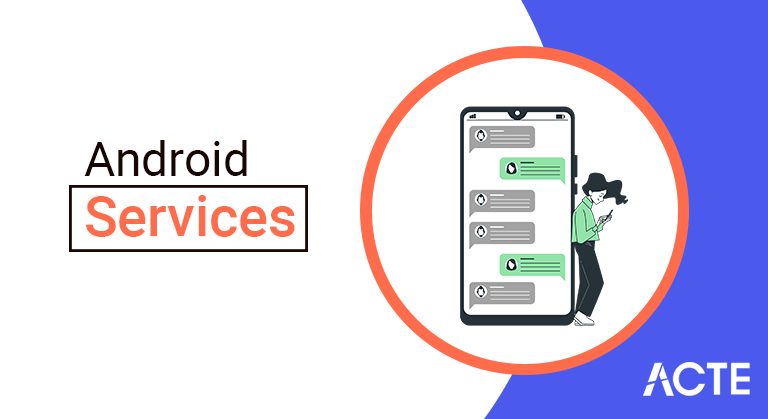
An Android service is a component that is designed to do some work without a user interface. A service might download a file, play music, or apply a filter to an image. Services can also be used for interprocess communication (IPC) between Android applications.
- Introduction to Android service
- Android Tools
- The Life Cycle of Android Services
- Types of Android service
- Fundamentals of Android Services
- Example of Android Services
- Why Android Services
- Defining custom services
- Benefits of Android Services
- Conclusion
Introduction to Android service:
The service is part of an application that can perform tasks that last longer. It does not provide a user interface. Once started, the service may continue to run for a period of time, even after the user has switched to another application. Additionally, the component can bind to the service to interact with it and even make interprocess communication (IPC). For example, the service can manage network activity, play music, create an I / O file, or collaborate with a content provider, all in the background.
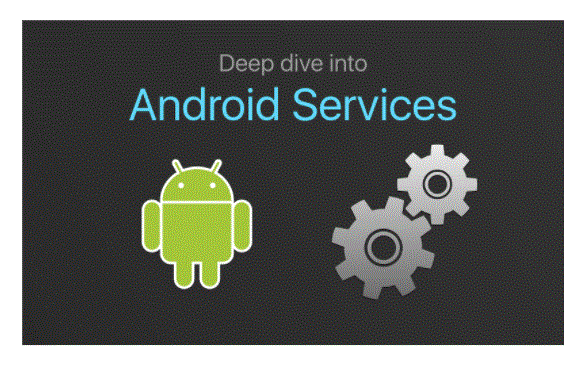
- SDK tools
- Platform tools
- Manage Android Visible Devices (AVD)
- Create and update Android projects
- Update your sdk with new platform additions and documents
- android [world options] action [action options]
- DDMS represents the Dalvik debug monitor server, which provides multiple services to the device. The service may include message formatting, call manipulation, screenshot scanning, internal networking and file systems, etc.
- It uses DDMS. From the Android studio click Tools> Android> Android device Monitor.
- On android, each program works with its own process and each process is run on a virtual machine. Each VM produces a different hole, an error fixer to which we can attach.
- When DDMS starts, it connects to adb. When the device is connected, a VM monitoring service is built between adb and DDMS, which notifies DDMS when the VM on the device is started or disconnected.
Android Tools:
Android developer tools allow you to create interactive and powerful apps for the android platform. Tools can usually be divided into two types.
SDK tools:
SDK tools are generally independent and are required no matter which android platform you are working on. When you install the Android SDK on your system, these tools are installed automatically. A list of SDK tools is provided below –
android- This tool allows you to manage AVDs, projects, and installed SDK components
dzm- This tool allows you to fix an Android apps error
Draw 9-Patch- This tool allows you to easily create a NinePatch image using the WYSIWYG editor
emulator- These tools allow you to test your apps without using a mobile device
mksdcard- Helps you create a disk image (sdcard external storage) that you can use with the template
guard- Reduce, enhance, and complicate your code by deleting unused code
sqlite3- Allows you to access SQLite data files created and used by Android applications
tracking- Provides viewer with images of activity logs saved by your application
abb- Android Debug Bridge (adb) is a multi-functional command line tool that allows you to connect to a simulation example or a power-connected Android device.
We will discuss three important tools here namely android, ddms and sqlite3.
Android
DDMS
- By calling the stopService () method,
- The service can be stopped using the stopSelf () method.
The Life Cycle of Android Services:
For android, apps have 2 possible ways to end its life cycle namely Launched and Restricted.
1. Activated Service (Unlimited Service):
Following this method, the service will start when the application component calls the startService () method. Once started, the service can continue continuously in the background even if the part is damaged that was responsible for starting the service. Two options are available to stop service delivery:
2. Integrated Service:
It can be managed as a server in the interface of the client-server. By following this method, parts of the android app can send requests to the service and can download results. Service is called a bond where part of the application commits itself to the service by calling the bindService () method. To stop using this service, all components must free themselves from the service using the unbindService () method.
Types of Android service:
1. Previous services:
Services that inform the user about their ongoing performance are called Advanced Services. Users can share the service with notifications provided about ongoing work. Like downloading a file, the user can track progress in downloads and can pause and restart the process.
2. Background services:
Background services do not require user intervention. These services do not inform the user about ongoing background activities and users also do not have access to it. Procedures such as synchronizing data or data storage fall under this service.
3. Responsible Services:
This type of android service allows app components as a function to bind themselves to it. Bonded services perform their function as long as any part of the application is tied to it. More than one component is allowed to commit to service at a time. To bind part of the application with the service bindService () method is used.
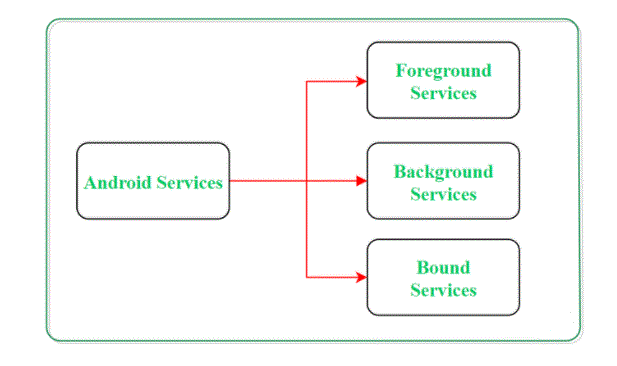
Fundamentals of Android Services:
User-defined service can be created with a standard classroom that extends Class service. In addition, to perform service functions in applications, there are certain re-call methods required to be performed. The following are some of the key features of Android Services:
onStartCommand ()
Android service calls this method if it is a component (eg activity). You are requesting to start a service using startService (). Once the service has started, can be stopped explicitly using setupService () or Self ().
onBind ()
This option is mandatory to use on android service and is requested whenever a program component calls the bindService () method to commit yourself to the ministry. The user interface is also provided for communication with service successfully by retrieving an IBinder item. If a service commitment is not required the method should also be empty.
onUnbind ()
The Android system requests this method when all clients disconnected from the interface of a particular service.
onRebind ()
If all clients are disconnected from a specific service interface again there is a need to connect the service with new customers, the system calls this method.
onCreate ()
Whenever service is performed using onStartCommand () or onBind (), the android system calls this method. This method is required to perform a simultaneous setup.
onDestroy ()
When the service is no longer running, the system calls this method just before the service was destroyed as the last cleaning call. Services should use this method to clean up resources as registered listeners, threads, receivers, etc.
- Click File, then New => New Project.
- Choose associate degree empty job
- Select a language like Java / Kotlin
- Select the minimum SDK per your would like.
- All cables employed in the work are listed during this file.
- “Services_In_Android”
- “Services on Android”
- “Start Service”
- “Stop service”
Example of Android Services:
Background music playback may be a quite common example of services on humanoid. From the instant the user starts the service, the music plays ceaselessly within the background notwithstanding the user switches to a different application. Users should stop the service expressly to pause the music. Below is the complete in small stages implementation of this humanoid service employing a few re-calling strategies.
Step 1: produce a replacement project
Step 2: Edit the strings.xml file
Step 3: operating with the activity_main.xml file
Open the activity_main.xml file and add a pair of Buttons thereto that may begin and stop the service.
Step 4: produce a custom service class
A custom service category is going to be an inbuilt constant directory wherever the MainActivity category resides and this category can expand the Service category. direct strategies are accustomed to launching and destroying resources. To play music, use the MediaPlayer object. Below may be a code to try and do this job.
Step 5: operating with the MainActivity file
Now, the button things are going to be proclaimed, and also the method by clicking on these buttons are going to be explained within the MainActivity category. Below may be a code to use this step.
Step 6: Edit the AndroidManifest.xml file
In order to use the apps effectively on any humanoid device, it’s vital to mention the service created within the AndroidManifest.xml file. it’s out of the question for the service to perform its performance unless otherwise expressed during this file. The name of the service is fixed among the app tag.
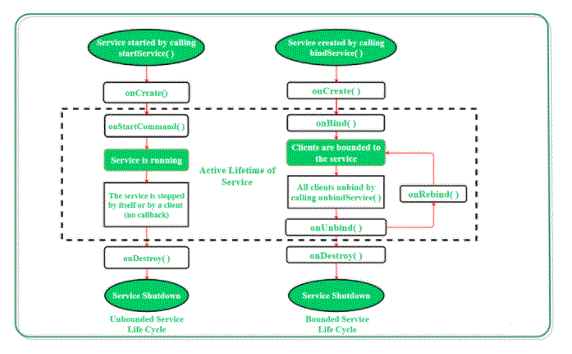
- By default, the service operates through the same process as the main app series.
- Therefore, you need to use asynchronous processing in the service to perform in-depth operations of the background. A commonly used pattern of service use is to create and use a new Series in the service to perform background processing and terminate the service once the processing is complete.
- The services that apply at the time of application are sometimes called local services.
- The Android app, in addition to using Android platform applications, can define and use new services. Defining your custom apps allows you to design responsive apps. You can download application data with it and once the application has been started by the user, it can bring new data to the user.
- Starting and explaining custom resources
- Custom services start with other parts of Android, namely, jobs, streaming receivers and other apps.
Why Android Services:
Platform service and custom services
Android Platform provides and uses pre-defined system services and all Android apps can use them, with the appropriate permissions. These system services are usually defined by a specific Manager section. Access to them can be obtained through getSystemService (). The Content section describes a few of the basics of accessing these services.
Previous services
Pre-service is a service that should have the same value and functionality so it should not be killed by the Android system, even if the system has low memory. The previous service must provide a status bar notification, placed under the heading “Continuing”, which means the notification can be canceled unless the service is suspended or removed from the front.
- MyService community class extends Service one thing helpful
- restore Service.START_NOT_STICKY;
- }
- @Override
- public IBinder onBind (Purpose) association to revive IBinder implementation
- replace null;
- }
- }.
- . begin service
- The mechanical man part (service, recipient, task) will activate service usage by launching the Service (purpose).
- // use this to begin and activate the service
- Purpose i = New purpose (context, MyService.class);
- // add knowledge to purpose
- PutExtra (“KEY1”, “Value for service”);
- umongo.startService (i);
- Alternatively, you’ll be able to restart the service victimization of the bindService () decision technique. This enables you to attach to the service. We’ll quote that later.
- The first method of service and operation
- If the startService technique (purpose) is named and also the service isn’t operating, a service object is formed and also the onCreate () service technique is named.
- Once the service is started, the onStartCommand (objective) technique of service is named. Switches to Object object from startService (objective) phone.
- If startService (purpose) is named a amount service is active, its onStartCommand () is additionally referred to as. thus your service has to be adjusted so onStartCommand () will be referred to as a number of times.
- What if you decide on this technique in your code? must you {be concerned|worry|be Associate in Nursingxious|fret|be troubled|agonize} concerning syncing an onStartCommand () route call? No, this technique is named the mechanical man system within the main user series, thus it can’t be referred to as at the same time from 2 completely different threads.
- The service is started one time, however usually you decide on the StartService () technique.
- 2.4. Service restart management
- In its onStartCommand () technique decision, the service returns Associate in Nursing int that describes its restart behavior just in case the service is terminated by the mechanical man platform. you’ll be able to use constants, the foremost common choices square measure delineate within the following table.
- Table 1. Restart choices
- Description Description
- Service.START_STICKY
- Service is restarted once disconnected. Objective knowledge transferred to the onStartCommand path is invalid. it’s used for services that own their region and aren’t addicted to Objective knowledge.
- Service.START_NOT_STICKY
- Service isn’t restarted. it’s used for sporadically activated services but. The service is restarted only when the operational time has unfinished startService () calls from the termination of service.
- Service.START_REDELIVER_INTENT
- Same as Service.START_STICKY however the initial purpose is additionally delivered to the onStartCommand path.
- Stopping service
- Stop the service victimization stopService () technique. despite what number of times you hit the StartService (intent) technique, one decision to the StopService () technique stops the service.
Defining custom services:
Implementation and proclamation The service has to be proclaimed within the AndroidManifest.xml file and also the category that’s victimized it ought to extend the Service category or one in every of its subsidiaries.
The following code shows an Associate in Nursing example of a service announcement and its use.
The service will disconnect itself by using the stopSelf () technique. This can be sometimes done once the service completes its operation.
- Android is based on Linux. This facilitates easy access to the area of rich development and basic functionality of the mobile device.
- Allows for faster data collection. It also provides the exact information required.
- The practice is greatly reduced.
- Development tools are easy to use.
- All information and services are provided by developers without bias.
- Provides rich browser services too. This helps the engineer to provide improved services.
- Google Android app. It can be done with or without the help of an Android application development company. The previous option is possible if the user is well-versed in Mobile Application Development technology. On the other hand, if an app developer does not have the ability to use the SDK tools provided by Android, the same option may reverse and lead to loss of time, money and resources. Most people choose the latest option and get professional services and Application Engineer.
Benefits of Android Services:
Some of the main benefits of this are as follows:
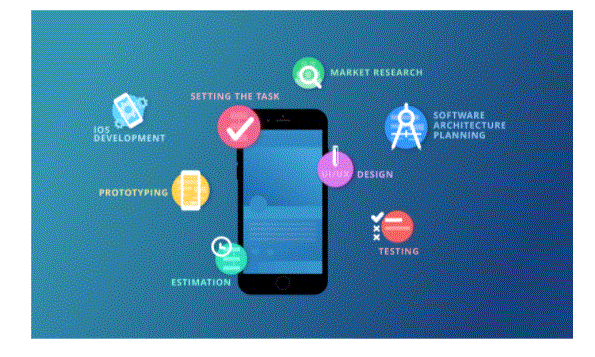
Conclusion:
Plan Background Tasks using Android Job Scheduler or Firebase Job Dispatcher – These two libraries provide a framework for background workflow applications, a separate unit of work. Apps may then configure the task by the operating system with specific terms about when the function can be activated.
Start service before – the front service is useful when the app has to do a certain task in the background and the user may need to occasionally engage with that function. The front service will display persistent notification so that the user knows that the app is using the background function and provides a way to manage or interact with the function. An example of this would be a podcasting app that plays back the podcast to the user or perhaps downloads a podcast episode for later enjoyment.
Use Firebase Cloud Message (FCM) most importantly – If Android finds the most important FCM application, it will allow that app to launch services later in the short term. This can be another great way to have a background service that votes for the app in the background.
Undo work if application comes first – If there are no previous working solutions, applications should upgrade their pause and restart function when the application comes earlier.

